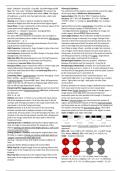Summary
Summary Cheatsheet For Image Analysis(800877-M-3) Final Exam (2 pages)
- Course
- Institution
Prepare effectively for your Image Analysis exam with concise and structured cheatsheet. Spanning 2 pages, this resource is tailored for exam success, offering a quick reference guide highlighted key topics. With designated areas for personal notes and example questions to help you tackle ch...
[Show more]




